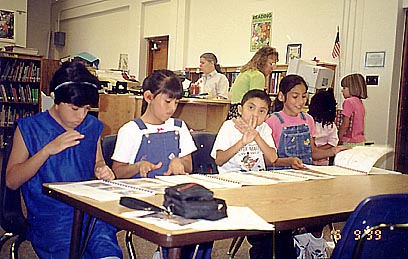|
by Alexandra Han
A controversial way to read, write and type one's
sign language, SignWriting (or SW) is an 'alphabet', or a list
of symbols, that can be used to write one's sign language. Like
the Roman alphabet, used to write many different spoken languages,
such as Danish, German, French, Spanish and English, SignWriting
can also be used to write many different sign languages. After
all, if many spoken languages can have written versions, why
not sign languages?
Resistance Against SignWriting: Why
It Is Controversial
Yet even within the Deaf communities, Sign Writing has been controversial
from the first time it was invented in 1974: either dismissed,
laughed at, or scorned. "Historically, new ideas that create
"social change" are always met with resistance in the
beginning, and SignWriting is no exception," points out
Valerie Sutton, creater of SignWriter.
Among reasons listened why SignWriting "should not"
be accepted:
1) Signed languages are not supposed to be written
2) Deaf people will become isolated and never learn to read and
write English
3) You have no right to write our language if you are a hearing
person
4) If I learn it, no one else can read it, so why bother?
5) I had trouble enough learning to read and write English,
why should I learn something new now as an adult?
6) I refuse to learn SignWriting unless other Deaf people back
it first!
Yet as SignWriting continues to evolve, it is gathering greater
acceptance, and its many uses, including a possible educational
advantage for Deaf and hard or hearing students, is slowly beginning
to be sensed by others. Interestingly, while both Deaf and hearing
adults struggle with their reactions to SW....
Deaf Children: Their Reactions
....Young children respond differently. They're drawn to it,
get excited about it, and will do this 'school work' harder,
and for longer periods. According to their teachers, they tend
to take about six months to learn the basics of SignWriting,
a relatively short time in their long academic education. They
also learn it more quickly than adults, being younger, unbiased,
and more linguistically flexible. Research is currently being
undertaken to determine whether SignWriting helps, or doesn't
help, these children's ability to read and write English - and,
perhaps more
importantly, their self esteem. From an elementary Albuquerque,
New Mexico school, this eight-years-old young student,Desi Baca,
chortles: "It's FUN!.....My favorite thing is to learn SW"
Asked if she thought it will be hard for deaf people, she signed
emphatically (In ASL), "No, it's easy for Deaf people"
(because they already know signs). About the SignWriter program,
in which one can type in the symbols for SW, she signed emphatically,."I
admit I like to use the computer! It's a lot of fun to make up
stories, and it is beautiful". When asked to clarify what
is beautiful, she pointed to the instructional manual with the
signs and SW symbols illustrated in color, and signed, "I
like (the symbols)....they are beautiful".
Another young student, Jazmine Martinez, reminded of the occasion
when she found the sign for 'girl' in the SignWriter dictionary
and became very excited at finding it, giggled, and commented
'(That sign) 'girl', yes, you are right!', then proudly demonstrated
some other signs she found using the SignWriter dictionary, such
as 'bug' and 'cat'.' As to her favorite book, "I read it
at home. I sit and look at the signs (written in SW) and then
write the word...I will work for a long time in my room when
my mom goes to the store". Other teachers have reported
similiar reactions...
...continued
page 2...
|

